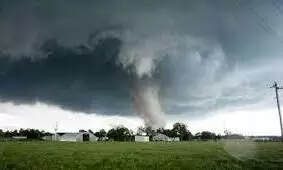
Tornado season in the US: 478 tornadoes recorded in 2023
text_fieldsWashington: The US has seen at least 478 tornado reports in 2023. The data is concerning because this is one of the highest numbers the country has seen in the recent past. The only higher numbers were in 2017 (503 tornados) and 2008 (523 tornados). But they were throughout the entire year.
The number of tornadoes hitting the US in a year usually keeps under and around 200.
Experts think that the warmer-than-usual winter across the South is fuelling the destructive tornadoes.
Harold Brooks, a senior research scientist at the National Oceanic and Atmospheric Administration’s National Severe Storms Laboratory, told NBC News that mild winter conditions create a type of atmospheric instability in early spring. This becomes a big contributor to severe storms that lead to tornadoes. "If you don’t get the cold fronts across the Gulf, all you need is a little bit of wind to bring in a lot of warm, moist air. And this has been a year where cold fronts really haven’t gotten that far south. The southern part of the U.S. was not particularly cold this winter."
Scientists think the South of the country will become more vulnerable as global warming progresses. Southern states like Alabama, Mississippi, and Tennessee are more at risk. Researchers have been studying how tornado activity will change in a warming world. But more data is needed.
Walker Ashley, an atmospheric scientist at Northern Illinois University, added that the underlying social landscape of a place like Mississippi compared to, say, Kansas is the primary driver in the difference in impact. The South of the US is more densely populated than the rest of the country. "There’s a lot of people spread out across the landscape in the South, so the odds of somebody being impacted is far greater in Mississippi or Alabama or Arkansas or Tennessee."























